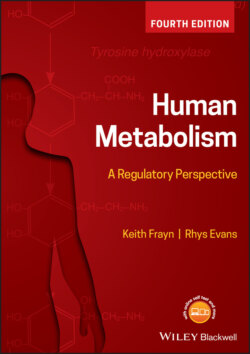Читать книгу Human Metabolism - Keith N. Frayn - Страница 33
1.3.2 Carbohydrate metabolism 1.3.2.1 Pathways of glucose metabolism
ОглавлениеCarbohydrate metabolism centres around the hexose sugar glucose (Figure 1.7). Glucose is a ubiquitous sugar which may be derived from dietary carbohydrate or synthesised in the body. It is stored in polymeric form as glycogen: this removes the osmotic problems that would arise if it were stored in cells as free sugars (Section 1.2.2.1). Glucose, as a polar molecule, cannot cross membranes composed of phospholipid bilayers by diffusion, and two families of glucose transporter proteins (GLUTs, and sodium-glucose linked transporters, SGLTs: see Chapter 2, Box 2.2), expressed in a tissue-specific manner, facilitate its rapid movement in and out of cells. The pathways of glucose metabolism inside the cell are illustrated in simplified form in Figure 1.14, which shows the key steps of the various pathways responsible for its utilisation, disposal and production. Glucose can be stored as glycogen, used to provide 5-carbon sugars and NADPH for, e.g. nucleotide synthesis, and lipogenesis, respectively, and split into pyruvate for further metabolism. It can be synthesised by gluconeogenesis, or by breaking down glycogen.
Figure 1.14 Pathways of glucose metabolism inside the cell. The pathways of glucose (carbohydrate) metabolism are shown with the key (regulatory and energy-yielding) steps marked. Glycolysis (splitting of glucose) is the major top-to-bottom pathway, and it results in two pyruvate molecules: i.e. fructose 1,6-bisphosphate is split, and the products are doubled. G 6-P, glucose 6-phosphate; F 6-P, fructose 6-phosphate; F 1,6-BP, fructose 1,6-bisphosphate; PEP, phosphoenolpyruvate; OAA, oxaloacetate.
